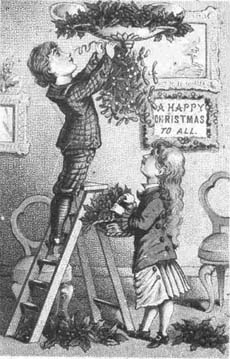The Holly and the Ivy
by Julia Hickey
The holly and the ivy,
When they are both full grown
Of all the trees that are in the wood
The holly bears the crown.
 Front doors sprout wreaths and red ribbons; florists
display gleaming sheathes of holly and pale spikes of mistletoe;
fir trees resplendant with lights and baubles fill open spaces by
every hearth. Families across the country venture out from the
warmth of their homes on wreath-making, garland-making and table
decoration workshops like those held at Rufford Abbey in
Nottinghamshire to spend an afternoon fashioning sprigs of
festive greenery into traditional decorations. The warm glow at
the end of such an afternoon has nothing to do with the weather
or hands stung by holly prickles. It has much more to do with
memories and laughter. Christmas has arrived! Front doors sprout wreaths and red ribbons; florists
display gleaming sheathes of holly and pale spikes of mistletoe;
fir trees resplendant with lights and baubles fill open spaces by
every hearth. Families across the country venture out from the
warmth of their homes on wreath-making, garland-making and table
decoration workshops like those held at Rufford Abbey in
Nottinghamshire to spend an afternoon fashioning sprigs of
festive greenery into traditional decorations. The warm glow at
the end of such an afternoon has nothing to do with the weather
or hands stung by holly prickles. It has much more to do with
memories and laughter. Christmas has arrived!
Today decorations appear at the beginning of December, if not
earlier, but in times past winter greenery was not allowed over
the threshold of many houses until Christmas Eve for fear of ill
luck. Even then not all evergreens were welcome. Ivy was used
to decorate the exterior of domestic buildings, never the inside.
Ironically perhaps, despite being the symbol of Bacchus -- -god
of wine and merriment -- ivy did manage to find its way into
church buildings where holly and mistletoe didn't. Look
carefully at decorative leaf patterns in churches -- you are more
likely to find ivy than any of the other evergreen varieties.
Westminster Abbey is home to a fine example, as is Southwell
Minster in Nottinghamshire where visitors can see a stone goat
tucking in to an ivy leaf lunch.
 Mistletoe, by contrast, is rarely seen
inside a church even now. Its links with druids and paganism are
too strong. An attempt was made to make mistletoe acceptable in
the early church. The tale grew that mistletoe was once a full
sized tree but when it was used to construct Christ's cross it
shrank with shame. The story cut no ice and mistletoe remained
firmly outside church boundaries. However, with its supposedly
magical properties -- protecting against lightning, bringing good
luck, curing disease and granting fertility -- it has always
featured in secular festivities. A mistletoe bough was often
suspended in the centre of a room or over a doorway. In the
eighteenth century the bough was transformed into a 'kissing
ball' under which hopeful young women waited for a kiss. The girl
who received seven kisses from seven different men would marry
one of them within the year. In Victorian times the kissing
continued but for every kiss a berry had to be removed and when
there were no more berries there were no more kisses. Mistletoe, by contrast, is rarely seen
inside a church even now. Its links with druids and paganism are
too strong. An attempt was made to make mistletoe acceptable in
the early church. The tale grew that mistletoe was once a full
sized tree but when it was used to construct Christ's cross it
shrank with shame. The story cut no ice and mistletoe remained
firmly outside church boundaries. However, with its supposedly
magical properties -- protecting against lightning, bringing good
luck, curing disease and granting fertility -- it has always
featured in secular festivities. A mistletoe bough was often
suspended in the centre of a room or over a doorway. In the
eighteenth century the bough was transformed into a 'kissing
ball' under which hopeful young women waited for a kiss. The girl
who received seven kisses from seven different men would marry
one of them within the year. In Victorian times the kissing
continued but for every kiss a berry had to be removed and when
there were no more berries there were no more kisses.
An opportunity occurs every year to take part in the 200-year-old
Mistletoe Auction in the Worcestershire Town of Tenby Wells.
Wrap up well to see the bulk of English mistletoe brought and
sold on Tuesday 29th November, the 6th and the 13th of December
in 2005. The atmosphere is electric as prices rise and fall.
People chatter excitedly and old hands comment on the state of
the boughs for sale, not to mention the previous summer's weather
conditions. Take part in this historic event and soak up the
atmosphere. Close your eyes for a minute and listen to the sounds
around you. It's not so hard to imagine jeans and waterproofs
swapped for long skirts, breeches, shawls and top hats. At the
end of the day when everyone has gone nothing remains but the
remains of white berries and a few leaves on the ground- until
next year.
 Holly is also sold at the auction. This, of course, is the plant
most commonly associated with Christmas. It made the transition
more satisfactorily from a pagan past into the Christian present.
It is also said that holly wood was used to construct Christ's
cross. The berries the holly bore were once yellow but turned
red in remembrance of Christ's blood, whilst the leaves became
symbolic of everlasting life. Its pagan past protects from
lightning strikes, causes cows to thrive and drives away demons
and evil spirits. Take a good look at the hedges that grow
around church yards -- chances are that you'll see holly bushes
growing alongside yew trees. Yews not only provided wood for
English longbows but protected people from unquiet spirits and
witches. Old houses often have either a yew tree or a holly bush
growing next to the main entrance for protective purposes!
Holly is also sold at the auction. This, of course, is the plant
most commonly associated with Christmas. It made the transition
more satisfactorily from a pagan past into the Christian present.
It is also said that holly wood was used to construct Christ's
cross. The berries the holly bore were once yellow but turned
red in remembrance of Christ's blood, whilst the leaves became
symbolic of everlasting life. Its pagan past protects from
lightning strikes, causes cows to thrive and drives away demons
and evil spirits. Take a good look at the hedges that grow
around church yards -- chances are that you'll see holly bushes
growing alongside yew trees. Yews not only provided wood for
English longbows but protected people from unquiet spirits and
witches. Old houses often have either a yew tree or a holly bush
growing next to the main entrance for protective purposes!
And then of course there are the Christmas trees. Famously, the
tree in London's Trafalgar Square is a gift from the people of
Oslo in recognition for Britain's role in helping them during
World War Two (see Christmas in London.) Today the decorations
wouldn't be complete without a Christmas tree taking centre
stage. People spend hours searching for exactly the right
specimen. However, firs are relative newcomers on England's
evergreen decoration scene. It was only when Prince Albert set
up a Christmas tree in Windsor Castle in 1841 for his family that
the German practice began to spread in England.
 The German tradition
which Prince Albert remembered from his own childhood is an old
one. Martin Luther said that the lights on a Christmas tree
reminded him of the starry heavens from which Christ descended at
the nativity. The Christmas tree has a number of legends
attached to it. One of them states that St Boniface, an English
monk, travelling in Germany came upon a pagan festival dedicated
to the worship of trees. He felled the tree that was being
worshipped and the following morning a fir tree had sprung from
the roots. More bloodthirsty versions of the story state that
Boniface actually saved a child from being sacrificed. Another
story suggests that a poor family took in a child who begged for
a night's shelter. The next morning he gave them a fir bough,
which promptly burst into flower as soon as it was planted -- a
promise of life everlasting. All these legends build upon a
pagan past. Druids worshipped trees -- most especially the oak
-- and decorated them with fruit and lights. Romans celebrating
their own midwinter festivities at Saturnalia also decorated
trees with trinkets and candles. One thing is certain:
evergreens have always been revered in the long cold days of
winter when warmth and the new life of spring is far away. The German tradition
which Prince Albert remembered from his own childhood is an old
one. Martin Luther said that the lights on a Christmas tree
reminded him of the starry heavens from which Christ descended at
the nativity. The Christmas tree has a number of legends
attached to it. One of them states that St Boniface, an English
monk, travelling in Germany came upon a pagan festival dedicated
to the worship of trees. He felled the tree that was being
worshipped and the following morning a fir tree had sprung from
the roots. More bloodthirsty versions of the story state that
Boniface actually saved a child from being sacrificed. Another
story suggests that a poor family took in a child who begged for
a night's shelter. The next morning he gave them a fir bough,
which promptly burst into flower as soon as it was planted -- a
promise of life everlasting. All these legends build upon a
pagan past. Druids worshipped trees -- most especially the oak
-- and decorated them with fruit and lights. Romans celebrating
their own midwinter festivities at Saturnalia also decorated
trees with trinkets and candles. One thing is certain:
evergreens have always been revered in the long cold days of
winter when warmth and the new life of spring is far away.
There remains one more piece of festive greenery to be mentioned.
If you visit Glastonbury at the end of the year, look out for
the Glastonbury thorn. It's unusual because it flowers twice-
once in May and then again at Christmas. The reason? The thorn
is said to have sprung from the staff belonging to Joseph of
Arimathaea -- the owner of the tomb where Christ's body lay.
Joseph arrived in England with eleven followers. The weary band
stopped at the end of a long day's journey at a place now known
as Wearyall Hill. Joseph's staff threw out roots and immediately
began to blossom. Joseph took this as a sign that he should
remain in Glastonbury and found a church. The history of the
Glastonbury thorn became interwoven with kings when the tradition
grew of sending a budding bough to the monarch. Even today the
Queen receives a sprig of the hawthorn at Christmas. Sadly for
the original thorn, a puritanical roundhead saw paganism and
idolatry in the practice of watching for the tree to blossom at
Christmas, and chopped it down. Following the restoration of the
monarchy, an offshoot of the original thorn was replanted and the
tradition of the Glastonbury thorn has continued.
 Don't expect to see it flower on the 25th
December, though. The English calendar changed by ten days in
1752 when the Gregorian calendar was adopted. The thorn flowers
according to the Julian calendar: on January 5, Old Christmas
Day. Interestingly, the thorn is of the kind more commonly found
in Palestine and Israel -- perhaps it was carried home by a
crusader or a merchant or perhaps it really was fetched from
distant shores by Joseph of Arimathaea! Don't expect to see it flower on the 25th
December, though. The English calendar changed by ten days in
1752 when the Gregorian calendar was adopted. The thorn flowers
according to the Julian calendar: on January 5, Old Christmas
Day. Interestingly, the thorn is of the kind more commonly found
in Palestine and Israel -- perhaps it was carried home by a
crusader or a merchant or perhaps it really was fetched from
distant shores by Joseph of Arimathaea!
Finally, what about the carol The Holly and the Ivy? The
holy represents the crown of thorns. The word holly is derived
from the Saxon word 'holen' meaning holy, so it has always been
an important evergreen plant. The ivy represents the Virgin Mary
-- a link to Greek myth, perhaps, that tells the story of a girl
who loved Dionysus so much that he placed her into the plant
which bears her name, its clinging embrace a reminder of her
love. All of which goes to show that history isn't just in the
buildings we visit: our history is very much alive in the things
we do and the words we use, even if we don't always know it.
More Information:
We regret that we no longer have the resources to maintain up-to-date links and/or hours and pricing details for the various sites and attractions listed on this website. For more information about the location(s) listed above, please use your favorite search engine or visit Wikipedia.
Julia Hickey is passionate about England's heritage and particularly of Cumbria, where her husband comes from. In between dragging her family around the country to a variety of historic monuments, she works part-time as a senior lecturer at Sheffield Hallam University. She spends the rest of her week writing. In her spare time, she enjoys walking, dabbling in family history, cross-stitch, tapestry and photography.
Article © 2005 Julia Hickey
|
